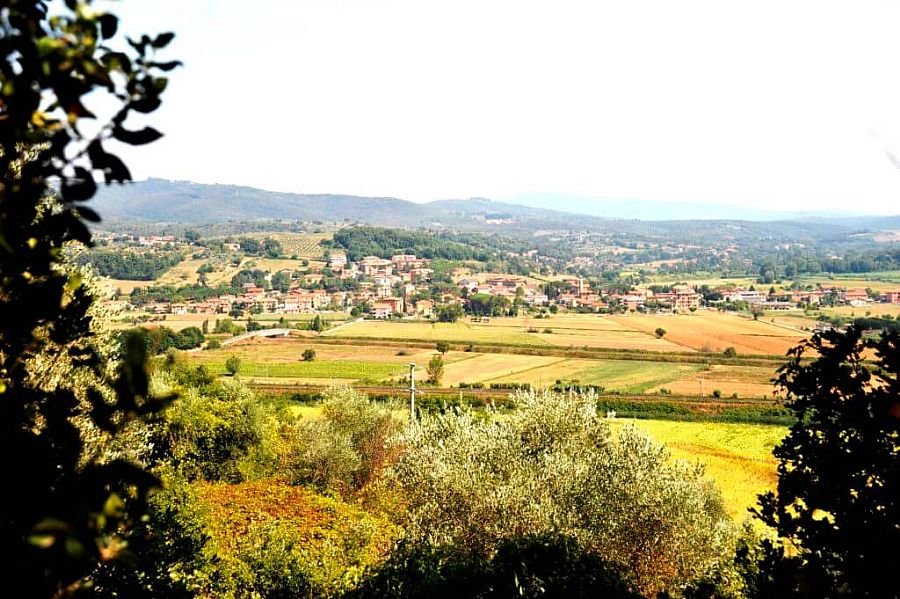Città della Pieve

Citta' della Pieve sits prettily on a hill where Umbria skirts the border of Tuscany. The walled amber-hued town is built entirely of brick, giving it a lovely uniformity. In fact, it was a center for brick manufacturing in the middle ages, along with textiles. The warm colors and architectural harmony give it a welcoming feel. The town is nestled in its ancient protective walls, like a nested jewel. The overall atmosphere is charming and vibrant. The surrounding countryside is swathed in sunflowers and olive trees.
The Etruscans and Romans once tromped over this part of the land, but the city itself developed in the tenth century when low-land dwellers moved uphill to avoid the unhealthy marshes of the poorly-drained valleys. An Etruscan obelisk dating back to the 6th century BC was found nearby, however, and is on display in the Palazzo della Corgna. That palazzo is the most notable in the city, it now houses the library and a natural history museum. Another noteworthy palace, Palazzo Bandini in via Roma, was built by former mercenaries-for-hire, the Bandini brothers, who lent themselves to the causes of Florence and Venice.
The most famous home-town boy was Pietro Vannucci, better known by his artistic name of Il Perugino, who left a vivid mark on his birthplace in the form of frescoes. The most famous is The Adoration of the Magi, a striking Nativity scene that he painted in the Oratory of Santa Maria dei Banchi, completed in just 28 days. The Cathedral, the church of Santa Maria dei Servi, and the church of San Pietro also house some of his masterpieces, and many travelers come here just to do "the Perugino trail".
The town's theater is a beautiful jewelry box of an opera house decked with satins and velvets, lined with private viewing boxes. A performance here feels like a real special event. The Pievesi also lay claim to have one of the narrowest streets in Italy, called via Baciadonna, because it's so slim that one can lean out the window and kiss the girl in a building on the other side! Wander the streets and take in the atmosphere; it's a captivating town with a vibrant civic life despite its small size. There are several excellent eateries and appealing caffes.
Citta'della Pieve hosts two colorful annual events: the Infiorata and the Palio dei Terzieri. The Infiorata strews the streets with flower petals in decorative designs to honor the town's patron saint, San Luigi. It's held the Sunday closest to June 21. The Palio dei Terzieri is a Renissance-era festival where the three districts duke it out in an archery contest, accompanied by costumed fanfare, parades, and merriment. There are "tavernas" with delicious regional food specialties. Held the second-to-last weekend in August.
Citta' della Pieve is noted for its blending of Umbrian and Tuscan cuisine, using the fruits of the forest like truffles and porcini mushrooms, hand made pastas, and exactingly-cured meats for which Umbria is famous. The area is noted for the cultivation of saffron, harvested by hand from crocus blossoms.
Citta' della Pieve is perfectly located for exploring the sights of Umbria and Tuscany, just off the A-1 autostrada, overlooking Lake Trasimeno. The famous towns of Cortona, Arezzo, Montepulciano, Perugia, Orvieto, and more can be easily reached from here.
Have you seen our self-catering apartments in Città della Pieve?

 Amalfi Coast
Amalfi Coast Sorrento Coast
Sorrento Coast Tuscany
Tuscany Cilento National Park
Cilento National Park Lake Como
Lake Como Rome and Latium
Rome and Latium Umbria
Umbria Capri and Ischia
Capri and Ischia Venice
Venice Puglia (Apulia)
Puglia (Apulia) Liguria
Liguria Sicily
Sicily Lake Maggiore
Lake Maggiore Lombardy
Lombardy Sardinia
Sardinia Lake Garda
Lake Garda Abruzzo and Marche
Abruzzo and Marche Calabria
Calabria

